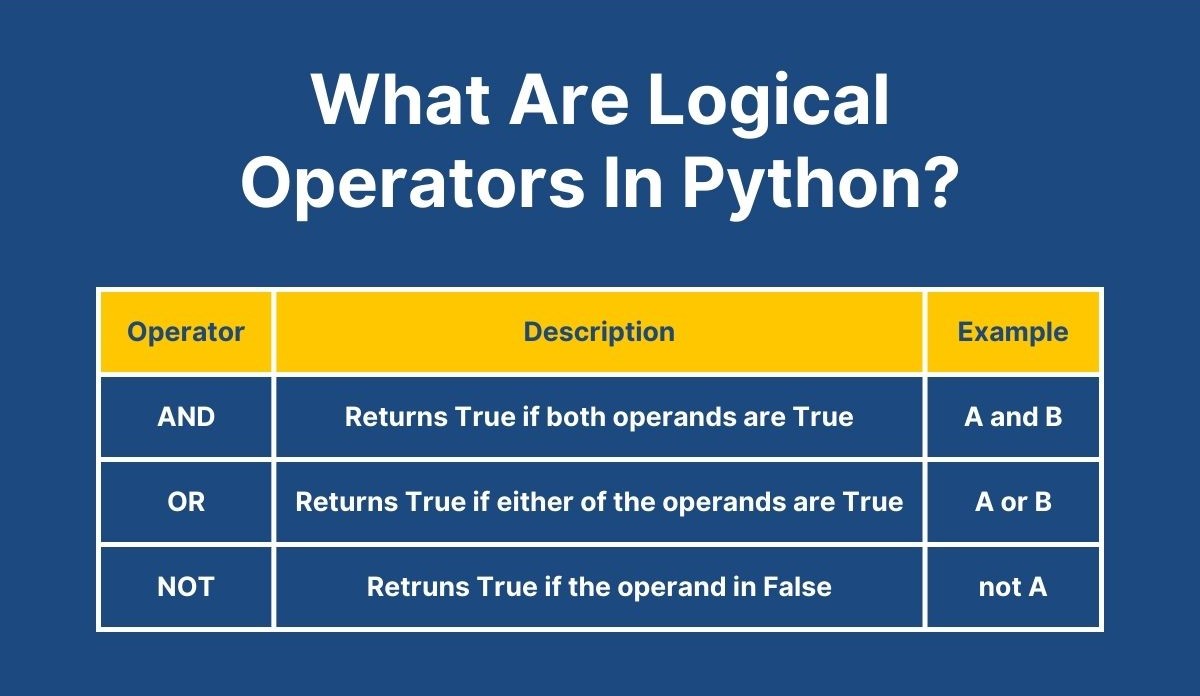Python's logical operators are fundamental building blocks for creating conditional expressions and controlling program flow. Among these operators, the "and" operator plays a crucial role in combining conditions and evaluating Boolean logic.
How the "and" Operator Works
In Python, the "and" operator takes two expressions and returns True only if both expressions evaluate to True. Otherwise, it returns False. This behavior makes it perfect for scenarios where multiple conditions must be met simultaneously.
# Basic usage of the "and" operator
x = 5
y = 10
if x > 0 and y > 0:
print("Both x and y are positive")Short-Circuit Evaluation
Python employs short-circuit evaluation with the "and" operator. If the first operand evaluates to False, Python doesn't evaluate the second operand since the entire expression will be False regardless. This behavior can be leveraged for efficient code:
# Short-circuit evaluation
def potentially_expensive_function():
print("This function was called")
return True
x = 0
# The function is not called because x > 0 is False
if x > 0 and potentially_expensive_function():
print("This won't be executed")Operator Precedence
The "and" operator has higher precedence than "or" but lower than comparison operators like ==, <, and >. When combining multiple logical operators, parentheses help clarify the intended logic:
# The "and" operator has higher precedence than "or"
result = True or False and False # Evaluates to True
# Equivalent to: True or (False and False)
# Using parentheses for clarity
result = (True or False) and False # Evaluates to FalseBeyond Boolean Values
In Python, the "and" operator doesn't always return a Boolean value. It returns the last evaluated operand, which allows for interesting patterns:
# The "and" operator returns the last evaluated operand
result = "Hello" and "World" # Returns "World"
result = "" and "World" # Returns "" (empty string)
# This can be used for default values
username = user_input and "Anonymous" # If user_input is empty, use "Anonymous"Common Use Cases
The "and" operator is frequently used in:
- Form validation and data processing
- Access control and permission checks
- Filtering data based on multiple criteria
- State management in applications
Practical Examples
User Authentication
def authenticate_user(username, password, role):
is_valid_username = validate_username(username)
is_valid_password = validate_password(password)
has_permission = check_permissions(role)
if is_valid_username and is_valid_password and has_permission:
return "Authentication successful"
else:
return "Authentication failed"Data Filtering
# Filter a list of products by multiple criteria
def filter_products(products):
premium_in_stock = [
product for product in products
if product['is_premium'] and product['in_stock'] and product['price'] > 100
]
return premium_in_stockRange Checking
# Check if a value falls within a specific range
def is_valid_temperature(temp):
return 0 <= temp and temp <= 100 # Between 0 and 100 degreesCombining with Other Operators
The "and" operator can be combined with "or" and "not" to create complex conditional expressions:
# Combining logical operators
is_weekend = day == "Saturday" or day == "Sunday"
is_morning = 5 <= hour and hour < 12
is_working_hours = not is_weekend and is_morning
if is_working_hours:
print("Time to work!")Truth Table for the "and" Operator
To understand the behavior of the "and" operator systematically, consider this truth table:
| Expression A | Expression B | A and B |
|---|---|---|
| True | True | True |
| True | False | False |
| False | True | False |
| False | False | False |
Advanced Techniques
Chaining Comparisons
Python allows chaining comparisons with the "and" operator implied:
# Traditional way
if x > 0 and x < 10:
print("x is between 0 and 10")
# Python's chained comparison (more readable)
if 0 < x < 10:
print("x is between 0 and 10")Using "and" with Collections
The "and" operator can be useful when working with collections and custom objects:
# Check if all collections are non-empty
lists_have_items = list1 and list2 and list3
# This works because empty collections are falsy in Python
# and non-empty collections are truthyPerformance Considerations
When performance matters, consider these tips:
- Place conditions that are more likely to be False first to take advantage of short-circuit evaluation
- For very complex conditions, consider breaking them into separate if statements for readability
- When checking multiple conditions on the same variable, factor out common expressions
# Less efficient
if x > 0 and x < 100 and x % 2 == 0 and x % 5 == 0:
print("x meets all conditions")
# More efficient (assuming these conditions are checked frequently)
if x > 0 and x < 100:
if x % 2 == 0 and x % 5 == 0:
print("x meets all conditions")Common Pitfalls and How to Avoid Them
Confusing "and" with "&"
The "&" operator performs bitwise AND operations, not logical AND:
# Logical AND (evaluates to True or False)
result = True and False # False
# Bitwise AND (operates on each bit)
bit_result = 5 & 3 # 1 (binary: 101 & 011 = 001)Using "and" Instead of Comma in Function Calls
A common mistake for beginners:
# WRONG: This doesn't pass two arguments
my_function(arg1 and arg2)
# CORRECT: This passes two arguments
my_function(arg1, arg2)Forgetting Order of Operations
Always use parentheses when in doubt about operator precedence:
# Potentially confusing
result = a or b and c
# Clear intent
result = a or (b and c)In Summary
The "and" operator is a versatile tool in Python that goes beyond simple Boolean logic. Understanding its behavior, including short-circuit evaluation and return values, allows developers to write more concise and efficient code. By mastering this fundamental operator and avoiding common pitfalls, you can create more elegant and robust Python programs.
Similar Articles
https://docs.python.org/3/library/operator.html
https://www.programiz.com/python-programming/operators
More Articles from Python Central

